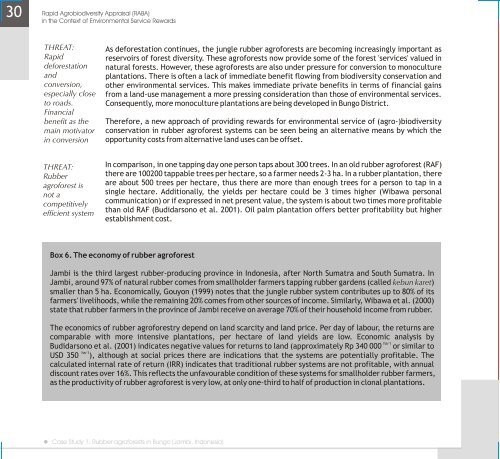Rapid Agrobiodiversity Appraisal (RABA) - Are you looking for one ...
Rapid Agrobiodiversity Appraisal (RABA) - Are you looking for one ...
Rapid Agrobiodiversity Appraisal (RABA) - Are you looking for one ...
You also want an ePaper? Increase the reach of your titles
YUMPU automatically turns print PDFs into web optimized ePapers that Google loves.
30<br />
<strong>Rapid</strong> <strong>Agrobiodiversity</strong> <strong>Appraisal</strong> (<strong>RABA</strong>)<br />
in the Context of Environmental Service Rewards<br />
THREAT:<br />
<strong>Rapid</strong><br />
de<strong>for</strong>estation<br />
and<br />
conversion,<br />
especially close<br />
to roads.<br />
Financial<br />
benefit as the<br />
main motivator<br />
in conversion<br />
THREAT:<br />
Rubber<br />
agro<strong>for</strong>est is<br />
not a<br />
competitively<br />
efficient system<br />
As de<strong>for</strong>estation continues, the jungle rubber agro<strong>for</strong>ests are becoming increasingly important as<br />
reservoirs of <strong>for</strong>est diversity. These agro<strong>for</strong>ests now provide some of the <strong>for</strong>est 'services' valued in<br />
natural <strong>for</strong>ests. However, these agro<strong>for</strong>ests are also under pressure <strong>for</strong> conversion to monoculture<br />
plantations. There is often a lack of immediate benefit flowing from biodiversity conservation and<br />
other environmental services. This makes immediate private benefits in terms of financial gains<br />
from a land-use management a more pressing consideration than those of environmental services.<br />
Consequently, more monoculture plantations are being developed in Bungo District.<br />
There<strong>for</strong>e, a new approach of providing rewards <strong>for</strong> environmental service of (agro-)biodiversity<br />
conservation in rubber agro<strong>for</strong>est systems can be seen being an alternative means by which the<br />
opportunity costs from alternative land uses can be offset.<br />
In comparison, in <strong>one</strong> tapping day <strong>one</strong> person taps about 300 trees. In an old rubber agro<strong>for</strong>est (RAF)<br />
there are 100200 tappable trees per hectare, so a farmer needs 2-3 ha. In a rubber plantation, there<br />
are about 500 trees per hectare, thus there are more than enough trees <strong>for</strong> a person to tap in a<br />
single hectare. Additionally, the yields per hectare could be 3 times higher (Wibawa personal<br />
communication) or if expressed in net present value, the system is about two times more profitable<br />
than old RAF (Budidarsono et al. 2001). Oil palm plantation offers better profitability but higher<br />
establishment cost.<br />
Box 6. The economy of rubber agro<strong>for</strong>est<br />
Jambi is the third largest rubber-producing province in Ind<strong>one</strong>sia, after North Sumatra and South Sumatra. In<br />
Jambi, around 97% of natural rubber comes from smallholder farmers tapping rubber gardens (called kebun karet)<br />
smaller than 5 ha. Economically, Gouyon (1999) notes that the jungle rubber system contributes up to 80% of its<br />
farmers' livelihoods, while the remaining 20% comes from other sources of income. Similarly, Wibawa et al. (2000)<br />
state that rubber farmers in the province of Jambi receive on average 70% of their household income from rubber.<br />
The economics of rubber agro<strong>for</strong>estry depend on land scarcity and land price. Per day of labour, the returns are<br />
comparable with more intensive plantations, per hectare of land yields are low. Economic analysis by<br />
ha-1<br />
Budidarsono et al. (2001) indicates negative values <strong>for</strong> returns to land (approximately Rp 340 000 or similar to<br />
ha-1<br />
USD 350 ), although at social prices there are indications that the systems are potentially profitable. The<br />
calculated internal rate of return (IRR) indicates that traditional rubber systems are not profitable, with annual<br />
discount rates over 16%. This reflects the unfavourable condition of these systems <strong>for</strong> smallholder rubber farmers,<br />
as the productivity of rubber agro<strong>for</strong>est is very low, at only <strong>one</strong>-third to half of production in clonal plantations.<br />
Case Study 1: Rubber agro<strong>for</strong>ests in Bungo (Jambi, Ind<strong>one</strong>sia)

















![CynefinFramework final [Read-Only]](https://img.yumpu.com/19017304/1/190x135/cynefinframework-final-read-only.jpg?quality=85)